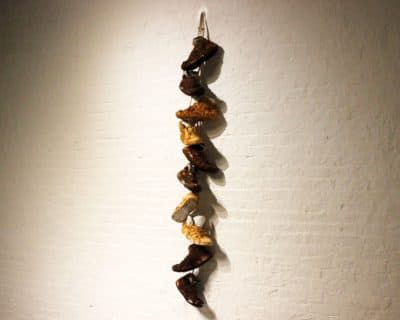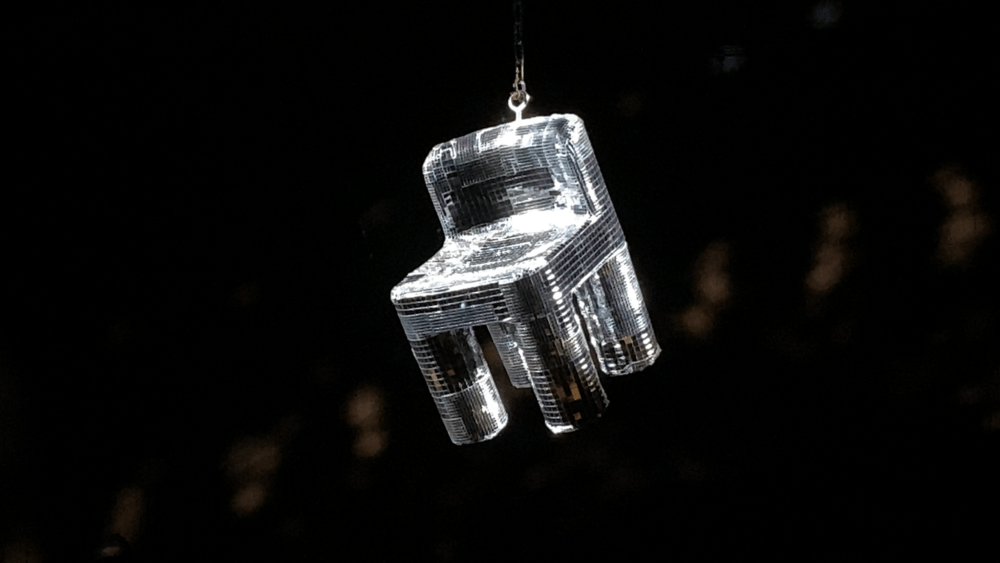Advertisement
Distillery Gallery Show Delves Into Rituals Outside Of Religion
When I arrive at the Distillery Gallery for a preview of its upcoming exhibition, “Hagiography or New Saints,” everyone is scattered throughout the space still at work. Artist Gregory Guy is leaning into some unforeseen (but perhaps serendipitous) destruction to the set that he built for his installation. It’s meant to be on display for the show along with a series of photographs taken on the set, which tell the story of a creature who protects the sewer while destroying everything else that lives there.

Another one of the artists, Shaka Dendy appears from the back where he’s been finishing up his work, “Ten Piece.” He greets me with a light fist bump, his gloved hands covered in chicken grease after battering and deep-frying 10 pairs of Adidas Top Ten sneakers (which smell really good).
“Hagiography or New Saints” is all about the rituals and relics of our everyday lives, and the meditation of secular routine particularly among people with marginalized identities. The show features the work of five artists who’ve approached the theme in divergent and exciting ways.
“I started thinking about the ritualistic aspect of fashion and food preparation, food and clothing, and how we prepare what we put in the body and on the body,” says Dendy. The Top Tens are presented the way one would present a ten-piece fried chicken meal. “It’s about how we look at so-called soul food and streetwear. Both of these things came out of spaces of not having enough, and then became the style, the culture.”
Curator Georden West moves through the chaos gracefully, checking in with each artist. They introduce me to Ena Kantardžić, whose piece, “Can You Hear Me Calling”, transforms a Little Tikes chair into a disco ball. Kantardžić had one of those chairs as a child and they used it as a jumping off point to explore innocence and safety, and the idea of the gay club as a church.

“Here in Boston, I’ve found solace in nightlife that I haven’t found in the ‘artlife,’” says Kantardžić. They say creativity lives in the nightclubs, where it has the space to thrive. Like the other artists in the show, Kantardžić is concerned about the lack of available, affordable creative space in the Boston area. The artists together shared with me their frustrations at policies that stifle and force out creative communities, like greater restrictions on bars and other nightlife venues, and the extreme costs and regulations associated with opening up new spaces that make the option unattainable for most.
“I think we have an interesting, inclusive scene building, maybe now more than ever. I just hope people don’t all leave,” says Kantardžić.
For some, Boston is a transient city. Thousands of students and short-term researchers move in and out every year. Kantardžić says that’s one of the things that can make it hard to build and sustain an enduring creative community. Most of the artists in the show didn’t know each other directly beforehand, and West was excited to facilitate their meeting.
This is West’s first curation, but they’ve exuded a clear-headed ‘if you build it, they will come’ energy as they’ve built and promoted the show. Last year, they presented their Student Academy Award-winning short film at the Distillery Gallery. Soon after, they started planning “Hagiography” as a way to recognize and honor alternative mythologies and rituals. They say that they reached out to artists they felt balanced reflection and foresight.
“[These artists] are using form to question the circumstances of where the Northeast is at and develop dialogue around it without falling into the pitfalls of identity,” West says.
Though the show deals with serious issues like isolation, displacement due to gentrification, and self-harm, it doesn’t take itself too seriously. There’s a sense of play to every piece in the show. Artist Norlan Olivo lives in Downtown Providence, and for him ritual means every morning waking up and checking to see if his car is parked in a safe spot or if he got a ticket (or worse, a boot). By his estimate, he has about 264 parking tickets from the City of Providence in the last decade. For the show, he cut a 2003 Toyota Echo in half and covered it in those parking tickets and others.
“I like the challenge of putting something so different in a gallery. This thing we’re used to seeing this one way, as a vehicle, is now political, and used in this tongue-in-cheek way,” says Olivo, adding that fiscally punitive city parking and traffic policies disproportionately affect poor communities.
From one perspective, this show is about the spaces and experiences one creates when they’re shut out from the hegemonic spaces and experiences. With “Hagiography” West invites us to glimpse the personal rituals and relics that arise when one removes the cloud of religiosity and social bondage from daily practice.
“These artists are critical to these conversations,” says West. “I think they’re some of the most exciting artists working in the Northeast, and I’m excited to show them all in one go.”
“Hagiography or New Saints” opens Friday, March 6, 7 p.m., at the Distillery Gallery, 516 East 2nd Street, Boston.
